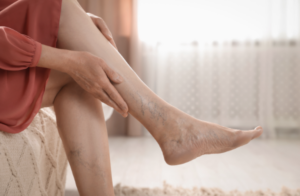
Varicose veins are a common condition that affects millions of people, causing discomfort, swelling, and sometimes even pain. These enlarged, twisted veins, often appearing blue or purple, typically develop in the legs and are the result of weakened or damaged vein valves. While they are often seen as a cosmetic concern, varicose veins can also lead to serious health complications if left untreated. Understanding the causes and risk factors associated with varicose veins can help you take preventive measures and seek timely treatment.
What Causes Varicose Veins?
To understand what causes varicose veins, it’s important to first look at how veins function. Veins are responsible for carrying blood back to the heart, and they contain one-way valves that prevent blood from flowing backward. When these valves become weak or damaged, blood can pool in the veins, causing them to enlarge and become varicose.
Several factors contribute to the development of varicose veins, including:
1. Weak or Damaged Vein Valves
The primary cause of varicose veins is the weakening of the valves inside the veins. When these valves fail to function properly, blood flows backward and accumulates in the veins, leading to their enlargement.
2. Increased Pressure in the Veins
Veins in the lower body, particularly in the legs, have to work against gravity to return blood to the heart. Increased pressure in these veins, due to prolonged standing or sitting, can make it more difficult for blood to circulate properly, leading to varicose veins.
3. Poor Circulation
A sedentary lifestyle or lack of physical activity can contribute to poor blood circulation, increasing the risk of developing varicose veins. Exercise helps strengthen the muscles that support healthy blood flow.
4. Hormonal Changes
Hormonal fluctuations, particularly in women, can play a role in the development of varicose veins. Pregnancy, menopause, and birth control pills can all affect vein elasticity and function, making women more susceptible to varicose veins.
5. Genetics
If your parents or close family members have varicose veins, you are more likely to develop them as well. Genetics can influence vein strength and function, making some individuals more predisposed to the condition.
6. Aging
As we age, veins naturally lose their elasticity, and the valves inside them can weaken. This makes it easier for blood to pool in the veins, leading to varicose veins.
7. Obesity
Excess body weight puts added pressure on the veins, making it more difficult for blood to circulate properly. This increased pressure can weaken vein walls and valves, leading to varicose veins.
8. Injury or Trauma
Previous injuries or surgeries on the legs can damage veins and their valves, increasing the likelihood of developing varicose veins.
Who Is at Risk for Varicose Veins?
While anyone can develop varicose veins, certain individuals are at a higher risk due to various lifestyle and genetic factors. Understanding these risk factors can help you take preventive steps to reduce your chances of developing varicose veins.
1. Women
Women are more likely than men to develop varicose veins due to hormonal influences from pregnancy, menopause, and birth control. Hormones like estrogen and progesterone can relax vein walls, making them more prone to valve dysfunction.
2. Individuals with a Family History
If varicose veins run in your family, your chances of developing them increase significantly. Genetics play a strong role in vein health.
3. People Who Stand or Sit for Long Periods
Jobs that require prolonged standing or sitting, such as nurses, teachers, office workers, and retail employees, increase the risk of varicose veins. Lack of movement makes it harder for blood to flow properly, leading to increased pressure in the veins.
4. Older Adults
Aging naturally weakens vein walls and valves, making older adults more prone to developing varicose veins. The risk increases significantly after the age of 50.
5. Pregnant Women
Pregnancy places extra strain on the veins due to increased blood volume and hormonal changes. Additionally, the growing uterus puts pressure on the veins in the legs, making varicose veins more likely to develop.
6. Overweight Individuals
Carrying excess weight increases pressure on the veins, making it harder for blood to circulate properly. This added strain can lead to varicose veins.
7. People with a History of Blood Clots
A history of deep vein thrombosis (DVT) or other blood clotting disorders can damage vein valves and contribute to the development of varicose veins.
How to Reduce Your Risk of Varicose Veins
While you may not be able to control all risk factors, there are steps you can take to reduce your chances of developing varicose veins:
- Stay Active: Regular exercise, such as walking, swimming, and cycling, helps improve circulation and strengthens leg muscles.
- Maintain a Healthy Weight: Losing excess weight reduces pressure on your veins.
- Avoid Prolonged Sitting or Standing: Take breaks to move around and stretch your legs if your job requires extended periods of sitting or standing.
- Wear Compression Stockings: These help improve circulation and reduce swelling in the legs.
- Elevate Your Legs: Raising your legs above heart level for short periods throughout the day can help improve blood flow.
- Stay Hydrated and Eat a Healthy Diet: A diet rich in fiber, antioxidants, and hydration can support vein health.
When to Seek Treatment
If you experience symptoms such as leg pain, swelling, heaviness, or skin discoloration, it may be time to seek medical treatment. At Vein Institute of Pittsburgh, we specialize in diagnosing and treating varicose veins with advanced, minimally invasive techniques that restore comfort and improve circulation.
If you’re concerned about varicose veins or would like to learn more about treatment options, contact the Vein Institute of Pittsburgh today for a consultation. Let us help you achieve healthier, pain-free legs!
